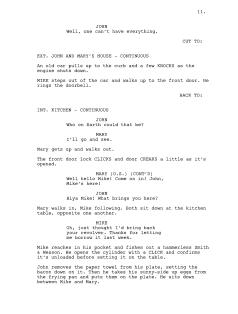 |
| What is the budget? |
1. What is your budget?
All clients have some kind of idea in their head of what they can afford to spend. £100, £500, £1,000? The answer to this question is the single most important factor in what you can deliver. After all, with animation you get nothing for free. Everything must be made from scratch.
2. How long is the final film?
Many clients, especially those who have never done animation before, will struggle to understand just how long animation takes to create. Finding out what the client's expectations are of the length of their project is vital. 30 Seconds? One minute? Two minutes? Find this out as early as possible.
 |
| Start with a script |
Many clients have no idea what story they want to tell. In this case, part of your job will be to write a script based on their idea. This can be fun, but also frustrating if the client has no idea what they want. But, you must have a script (also known as a screenplay) before you begin, else you are groping in the dark.
4. What style of animation?
Does the client have any animation or images in a style that they like? If they don't know, show them some clips from YouTube in styles that you like, or think you can reasonably achieve given the budget you have. Everyone likes Toy Story, but few clients can afford Pixar quality animation. Part of your challenge is to find a style that the client likes and that they can afford.
5. What is the deadline?
Next week? Next month? By Christmas? And is the deadline in any way flexible? Unrealistic deadlines are often a deal-breaker.
6. What is the target audience?
Who is it for? Kids? Businessmen? Adults? Teenage boys? This will affect the style of your storytelling and the tone of the film.
7. Is there a message the client wants to get across?
What feeling should the audience have after they have finished watching?
 |
| Find out who is directing. |
8. Who will approve the work?
Ideally, you want to get notes from one person only. It's a common problem to find that the client that you thought was making decisions has a number of bosses that they answer to, and you end up getting notes from multiple people you have never heard of.
These notes are often contradictory and can tie you up in knots. Try to make sure that one person is in charge, and that person gives you one set of notes.
9. What is the final output?
What does the client want at the end? A digital file? Film? A DVD? HD? 4K? What aspect ratio? Agree up front exactly what you will deliver. Sometimes clients want editable files so they can tinker with the edit, which can cause all kinds of problems with incompatible software and non-transferable files.
10. Payment schedule and contract
It's a good idea to agree terms in advance. Money up front? On completion? Half and half? Big clients will have a standard contract, smaller ones may look to you to draft a basic agreement.
For other freelance resources at Animation Apprentice, see these useful posts:
- Questions to ask the client on your first freelance job
- Maya Indie License (suitable for small freelance jobs)
- Sole Trader or Limited Company - which is best?
- Five Rules for Dealing with a Tricky Client
- Producer Steve Burch explains how to produce a freelance job
- Surviving and thriving as a freelance animator
- How to prepare your first invoice
- How to Make a Great Animation Demo reel
- Finding work in the animation industry
- Why animators need to be on LinkedIn.
- The Best Free Editing Software

No comments:
Post a Comment